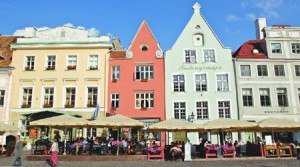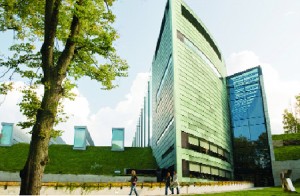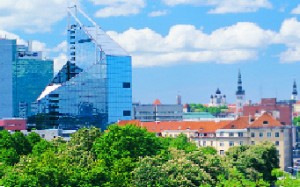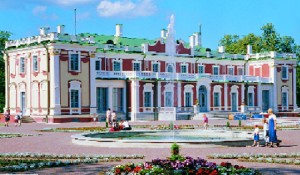The Jewish Traveler
Feature
The Jewish Traveler: Tallinn

Since the 13th century, Reval, Estonia’s ancient capital, was a trading post with an enviable location on the Baltic Sea. It became a geopolitical pawn throughout the ages because it was ruled by the Danes, the Swedes, the Russians, the Nazis and the Soviets.
In the center of Reval was Toompea, a 17-acre limestone hill featuring a castle, which overlooked the merchants, seafarers and conquerors that filled the maze of cobbled lanes, alleyways and squares in the town below. Formidable medieval fortifications protected the inhabitants and their gingerbread shops and homes. Whimsically named defense towers such as Fat Margaret and Kiek in de Kok (Peek into the Kitchen) stood tall like faithful sentinels and Gothic cathedral spires pierced the sky like a knight’s sword.
Reval was renamed Tallinn in 1918, and the capital city of the Republic of Estonia—which gained independence from the Soviet Union on August 20, 1991—has been reinvented through social, political and economic reforms. Today, Tallinn’s medieval charms meld neatly with modern conveniences, luring hoards of tourists seeking fairy tale enchantment with contemporary trappings. Tallinn, whose Old Town was designated a Unesco World Heritage Site in 1997, is one of Europe’s most beguiling cities. There is a kaleidoscope of events, particularly during the summer months, which features medieval and maritime festivals. The city’s food, fashion, artisan traditions and refined Estonian people complete the postcard picture.
Jews have added color to Estonia ever since their arrival in the 14th century, though their own history has been tumultuous. Permanent settlements did not begin until 1865, when Russian Czar Alexander II granted Jews the right to enter the region. Highly educated merchants and skilled artisans, they comprised the nation’s earliest semblance of a Jewish community. Jews lived within the city walls, particularly on Viru and Kullassepa Streets. Today’s Jewish Community Center is located a few minutes’ walk from the city walls.

History
Johannes the Jew was the first known Jewish reference, noted in a Tallinn Magistrate 1333 document. But it was the Cantonists—young Jewish soldiers in Czarist Russia—who established the first community in the mid-19th century, including a hevra kaddisha. However, Jewish settlements in Estonia never matched the numbers, wealth or religiousness of the Latvians and Lithuanians, their Baltic neighbors.
Estonia was not incorporated into the Russian Pale, the region of Imperial Russia in which Jews were granted permanent residency. Entry was contingent upon qualification, such as merchants of the first guild (aristocracy), Cantonists completing their service or medical doctors. The population soon grew beyond the capacity of the first prayer house.
Eventually, in 1885, the neo-Roman-style Great Choral Synagogue opened, to the delight of the 1,000-strong community.
When the country declared independence in 1918, 1,500 Jews lived in Tallinn. All the usual community networks were in place: Jewish schools, shops, yeshivot and kosher butchers. In 1926, the community was granted cultural autonomy and eventually formed 32 organizations. By the eve of World War II, the city’s Jewish population had doubled, with 5,000 Jews in the country overall.
But the good times came to an abrupt halt in 1940 when Estonia was incorporated into the Soviet Union and Jewish autonomy was terminated. In June 1941, 500 Jews were exiled to Russia. The Nazis, who had just invaded the Soviet Union, occupied Estonia a month later. It didn’t take long for them to build 22 labor and concentration camps. All but about 1,000 Jews retreated deeper into Soviet territory. By 1942, the Nazis had murdered those who remained and Estonia was the first state declared Judenfrei. The war over, Jews returned to Estonia, attracted by a comparatively high standard of living and the absence of official anti-Semitism, prevalent in the Soviet empire.
Community

“The community was starting from zero,” explains Efraim Shmuel Kot, chief rabbi of Estonia since 1999 and the nation’s first spiritual leader since the Holocaust, “because for so long there was a lack of community life during the Soviet time. Jewish Estonia became a place without traditions.”
Today, the Tallinn Jewish community is enjoying a spiritual and cultural revival thanks in large part to Kot, the Chabad representative who works for the Estonian Jewish Community (011-372-662-3050; www.ejc.ee). “In the last decade,” he says, “we built the framework with all the options to live as a Jew. Now, we need to insert as many Jews as possible…. I want people to be and feel Jewish not only in the [Jewish community] center, but also at home.”
Most of Estonia’s 2,000 Jews, including 700 Holocaust survivors, reside in Tallinn. More and more of them are participating at every level of Jewish communal life, made easier by abundant social and religious services that are on hand.
With a relatively robust economy, there is little incentive to seek greener pastures elsewhere, though some people split their lives between Tallinn and Israel. They also feel safe. The EJC has declared there is no official anti-Semitism, and there is only cursory security at community center facilities.
There are two official Jewish organizations in Estonia: the Jewish Religious Community and the Jewish Community of Estonia, which includes the Jewish communities of Tartu, Ida-Virumaa, Narva and Parnu, plus Maccabi, Women’s International Zionist Organization, the Ghetto Victims Association and World War II Veterans’ Association. There is also a Jewish Cultural Society.
Culture
The American Jewish Joint Distribution Committee (www.jdc.org/jdc-worldwide-programs/europe/estonia.aspx) played a big role in the rebirth of Estonian Jewish culture. It provides programs that reach all age groups, from social welfare programs that assist Holocaust survivors and economically challenged families, to educational and recreational activities, to holiday observance and celebration.
Reopened in 1990, the Jewish school (www.jkool.tln.edu.ee) has some 300 students in grades 1 to 12, and 50 kindergarteners. There are youth and sports clubs, such as the Maccabi football team and the Golden Age Camp for seniors. The JCC offers language lessons, Israeli folk dancing, computer lessons, food services for the infirm and elderly, a Sunday school and a beit midrash, among other programs. Travelers may participate in most events with advance notice to the JCC.
Since 2004, the Ariel Festival of Jewish Culture (www.festivals.ee/?s=108) has celebrated the community with book presentations, lectures, art exhibitions, film screenings, radio shows and concerts. The event unites Jewish communities across the country.

Tourist Office & Convention Bureau
Sights
A visit to Jewish Tallinn should begin at the Estonian Jewish Museum (662-3034; www.eja.pri.ee), located within the Estonian Jewish Community Center. Opened in December 2008, the exhibition tells the story of Estonian Jewry and is packed with text, photographs and artifacts. Museum director Juzef Luvistsuk and supply manager Marek Abel are usually on hand for guidance.
Also on the JCC campus is Synagogue Beit Bella (Tallinn Synagogue), the first synagogue built in postwar Estonia. The ultramodern, 180-seat facility opened on May 16, 2007, to architectural acclaim and international media attention. In addition to the main sanctuary, it houses the rabbi’s office, a mikve, a kosher restaurant and a gift shop. Symbolism is everywhere. The sanctuary, for instance, has a lofty arched ceiling, representing a connection to God. A wavy line wraps around the exterior, conveying the rises and falls in Estonian Jewish history. Tree motifs are carved into wood panels everywhere. Visitors can tour the community center, including a visit to the school and synagogue, with advance notice to the JCC office (office@jewish.ee).
Many of the Jewish remnants of the past have few or no markers. During much of the Soviet era, the community maintained a prayer house at 9 Magdalena Street, not far from Old Town. Originally a warehouse, the extant building is in a derelict state. A prayer room at 23 Kreutzwaldi Street preceded it between 1946 and 1966, but it was demolished to make room for a hotel.
The Old Cantonists’ Synagogue (1867 to 1870) still stands at 37 Uus Street in Old Town. It is a one-story, one-room stone edifice that today serves as the Estonian Maritime Museum.
Nearby, at 5 Maakri Street, was the former Great Choral Synagogue, which was destroyed in a March 1944 Soviet air-bombing raid. Nothing marks the site.
The Magasini Cemetery dates back to the beginning of the Jewish community. A plaque on the remaining wall, at 6 Magasini Street, reads: “Here was the Jewish cemetery from the 18th century until the end of the 1960s.” Today, the site is a parking lot for trucks, buses and, ironically, hearses.
Tallinn’s only active Jewish burial ground is Rahumae Cemetery, which opened in 1909. Visitors may be interested in the wooden hevra kaddisha building. There are also two notable memorials: One is for those who perished in the Holocaust; the other is for those who were deported, killed or exiled during Soviet occupation. Beila Barski, for whom the synagogue was named, is interred there. Alexander Bronstein, her son, was the project’s largest contributor.
Thirty miles west of town, Klooga concentration camp is commemorated by three memorials. Established in September 1943, inmates included Estonian political activists, Jews from ghettos in Lithuania and Latvia as well as Soviet Prisoners of War, common criminals and homosexuals. By the time the camp was liberated in September 1944, some 3,000 people had been murdered, half of them Jews from Vilnius, Lithuania.
There are two notable Holocaust memorials at Patarei Vangla (Battery Prison; www.patarei.org), which was built by Nicholas I of Russia in 1840; it became a prison in 1920 and a cultural park in 2007. One memorial is for 400 French Jews murdered during World War II, the other is for 207 Estonian Jews who died at the prison. Tours are available daily during summer months.
Other Sights
The Museum of Occupations (www.okupatsioon.ee) tells the story of the nation’s invaders from 1940 to 1991, a period during which the country was called the Estonian Soviet Socialist Republic. Exhibits include the Nazi occupation, though the story of the Holocaust is more fully told at the Jewish Museum.
On the lighter side, don’t miss Kadriorg Art Museum (one of five branches of the Art Museum of Estonia; www.ekm.ee), housed in the opulent Kadriorg Palace, an 18th-century seaside retreat built for Catherine I of Russia by her doting husband, Peter the Great. Just 20 minutes from the Old Town, the Petrine Baroque residence is a gem in the crown of a bygone era. The building and its magnificent gardens are a heavenly environment for viewing the 16th-to-20th-century European and Russian collections. Concerts and theatrical performances are also held there.
For Estonian art from the beginning of the 18th century through the end of World War II, the Kumu Art Museum is the place to go. Visitors can experience the life and food of yore at the Estonian Open Air Museum (www.evm.ee), a working re-creation of a traditional 18th-century rural fishing village. It features a dozen farmyards, a church, tavern, schoolhouse and fire station as well as a number of old buildings representative of Estonian architecture over the past two centuries.
Personalities
Contemporary figures include internationally acclaimed conductor Eri Klas (b. 1939). After beginning his career at the Estonia Theatre, he has since worked with orchestras worldwide, notably, the Royal Swedish and Finnish National Operas, and a number of philharmonics in America.
Samuel Golomb (b. 1957) hails from Rakvere and is a member of the Ida-Virumaa Jewish Community. As a radio and television personality, he is one of the community’s more colorful characters. He has appeared in infomercials, writes a news column and emcees weddings and funerals.
Books
There are a number of self-published books about the Jewish community available for download online.
The Jewish Community of Estonia (2001) by Eugenia Gurin-Loov and Gennadi Gramberg is a historical account beginning in the 16th century through nearly the present day. The book can be downloaded in part as a pdf file (www.eja.pri.ee/Community/Community_eng.pdf). It includes some fascinating photographs and sketches related to the community.
Museum Catalogue (Estonian Jewish Museum) is also available free online as a pdf file (www.eja.pri.ee/Catalog_eng.pdf). It is a thorough historical outline and includes an excellent timeline from 1333 through 2011. Chapters discuss the Holocaust, Jewish organizations, notable Jewish Estonians and the post-Soviet Union community rebirth.
The Tallinn New Synagogue (The Jewish Religious Community of Estonia) by Gennadi Gramberg includes a history of Jewish Tallinn, but also describes the development, construction and design of the new synagogue. It can be obtained at the synagogue.
Side Trips
The manmade Piusa sand caves in the extreme southeast of the country (www.piusa.ee) contain a system of galleries, columns and vaulted ceilings. They are the result of glass sand mining between 1922 and 1966. Entering the caves is unnerving because they are home to at least five species of bats. At Piusa Pottery (www.savikoja.ee), visitors can observe or participate in workshops that produce traditional ceramics. The four-and-a-half hour ride can be taken by bus or car.
Kohtla-Jarve, a two-hour bus ride east of Tallinn, is home to the 75-member Ida-Viruumaa Jewish community. The JCC is housed in a private apartment used solely for community events. Chairman Aleksandr Dusman (aleksandrdusman@gmail.com) welcomes visitors and can help arrange outings to nearby Holocaust memorial sites including Ereda, Kivioli and Vaivara concentration camps. In nearby Rakvere, travelers will enjoy the museum in the town’s 14th-century castle. The Russians destroyed the town’s synagogue in 1947, though the cemetery still remains.
From Tallinn, a 50-mile, 90-minute ferry ride takes you to Helsinki, Finland, for an easy and exciting day trip. Helsinki and its residents are charming and home to a thriving Jewish community (www.jchelsinki.fi). Visitors are welcome to tour or pray at the 105-year-old Helsinki Synagogue, capped by a Byzantine-style cupola. The JCC is in the same compound.
Recommendations
The Park Inn by Radisson, a modern, stylish hotel, is a five-minute walk from the JCC and synagogue, and 15 minutes from Old Town (7C Narva Maantee Road; 372-633-9800).
Hotel Viru Inn (8 Viru Street; 372-611-7600; www.viruinn.ee/eng) is a luxurious boutique hotel in Old Town, housed in a 14th-century merchant’s house—perhaps Jewish. Viru was the main Jewish trading street of its day.
For some local and Israeli food, try Jeruusalemm kosher restaurant (ground floor of the synagogue building, 16 Karu Street; www.jeruusalemm.ee/en) for schnitzel and borscht, soups and salads, fish and latkes. Everything is made fresh and served on linen tablecloths. Home and hotel delivery available; contact Kot (rabbi@ejc.ee), the JCC (office@ejc.ee) or call 372-510-2525. Kot is happy to welcome visitors to Shabbat meal but advanced registration is requested.
For individual and group Jewish-themed tours taking in many of the sights in Jewish Estonia, contact Ljubov Judeikina (372-5451-1861; alb@hot.ee): The price is 25 euro per hour (about $31).
For travelers seeking off-the-beaten-path destinations, Tallinn provides the right mixture of old and new, history and whimsical beauty.
Jono David is an American photographic documentarian of Jewish communities worldwide. His online photo archive can be seen at www.jewishphotolibrary.com.








 Facebook
Facebook Instagram
Instagram Twitter
Twitter
Leave a Reply